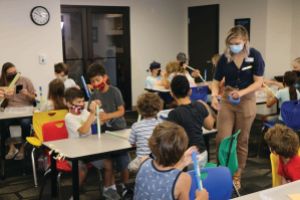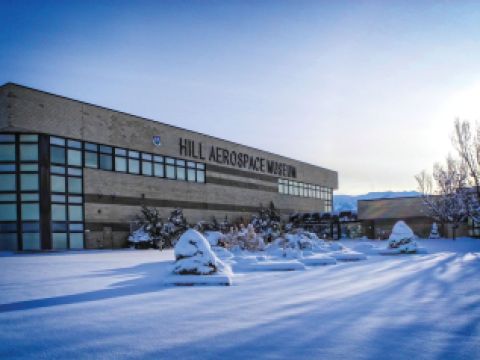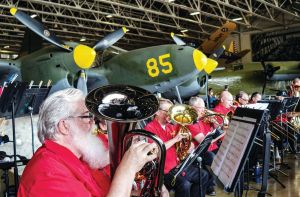
This article originally appeared in the January/February 2022 issue of Museum magazine, a benefit of AAM membership.
Hill Aerospace Museum’s accreditation journey put museum stakeholders on the same page, improved operations, and strengthened community connections.
Today, Utah’s Hill Aerospace Museum, a field museum of the US Air Force that houses aircraft from the national collection, is a center of the community. For all programs—education, restoration, collections, and more—the museum engages with the community before implementing any major changes. Community involvement, however, did not always occur.
About eight years ago, the Hill Aerospace Museum was at a crossroads: incredible and passionate stakeholders—federal staff and foundation members—kept the museum afloat, but the community no longer seemed to need the institution. Care for and focus on the collection had languished, and community involvement was nearly nonexistent. Bottom line, the museum seemed to be taking but not giving back. Senior leaders began discussing the possibility of closing the museum’s doors.

How does a museum that is so far lost recalibrate? For us, it began with the development of a strategic plan, the operational cornerstone for any museum, which eventually matured into the commitment to go down AAM’s accreditation pathway. Most people in our field consider accreditation the highest recognition of a museum’s commitment to public service, professional standards, and excellence in education. We knew that we needed to address these elements and more in our own museum.
At the beginning of our accreditation journey, and throughout the process, many asked us the same question: “Why do it?” Some asked this question because endorsement is not required of Air Force field museums. Some asked it because they knew the resource constraints of museums, especially Air Force field museums, and they wondered why we would use what little we had on a certification. Some asked the question because they saw no value in the status.
In the end, we found tremendous value in the accreditation program and the process. Because of the accreditation journey, the Hill Aerospace Museum did not have to close its doors and is a thriving institution today.
Why Accreditation?
I believe that everyone and everything can be improved at any time. Hill Aerospace Museum stakeholders feel the same, and we try to integrate this perspective into museum practice. Our institution’s vision is to “Become the premier Air Force field
museum—leading the way for others to follow.”
One of my biggest fears as a director is that the Hill Aerospace Museum will become the antithesis of a museum—instead of educating and inspiring, always groveling for donations and resources and becoming a burden to our communities.
In his 1859 lecture “Self-Made Men,” American abolitionist Frederick Douglass said, “Inaction is followed by stagnation. Stagnation is followed by pestilence, and pestilence is followed by death.” His words capture our viewpoint perfectly. If we do not work to develop ourselves and our institution—if we cease to be relevant—we become a burden to our community (and, in our case, also the US Air Force), and the museum will ultimately die.

After reviewing the AAM accreditation process in detail, and the preparatory path known as the Continuum of Excellence, we decided that it would be one of the primary steps that the Hill Aerospace Museum would take to breathe life back into our walls, our collection, our staff, our guests, and our communities—and not die by way of stagnation.
Building Our Foundation
At the heart of accreditation are core documents, and this is where our journey began as our team worked to get them verified when evaluated against a set of required standards. Core documents should not be unfamiliar to any museum, especially Air Force field museums. In fact, these foundational, guiding resources are expected by our Air Force instructions. For accreditation, AAM requires a mission statement, institutional code of ethics, strategic institutional plan, disaster preparedness and emergency response plan, and collections management policy. We had each of these documents before we began the accreditation process. However, after working closely with AAM staff and using their provided resources, it became apparent we had a lot of room to improve.
As we addressed our shortfalls, all stakeholders began to benefit from the accreditation process. For example, we lacked documented, sustainable, and repeatable processes for all facets of museum operations. Therefore, we got to work building the structure for all major institution processes with local operating instructions. Furthermore, we integrated more stakeholders into our strategic planning process, voices that were absent before.
This is not to say we, as a team, did not work well together before. In fact, all stakeholders—federal, foundation, and community—seemed in lockstep prior to this journey. Good things were happening. However, the accreditation process required a higher level of participation from everyone, sometimes to the point of discomfort. I believe discomfort can be helpful in life—and it was beneficial in the accreditation process. Hereafter, I will refer to our discomfort as “opportunity.”
Our new opportunity forced the staff and board to be thoughtful about past, current, and future practices as we adopted new strategic processes. We all gained a clearer sense of purpose and understanding of the museum’s strengths, goals, priorities, and mission—and, most importantly, our weaknesses. We initially met weekly, and now meet monthly, to review our core documents, and every month we find ways to improve or adjust. Recently, we recognized and explored opportunities to partner with local educational entities to benefit the community and the museum collection. We have since signed an agreement with a local technical college to conduct composite manufacturing courses in the museum in which students will have the opportunity to apply what they learn in the classroom (located on our campus) to aircraft in the collection.
Recognition by AAM depends on your institution’s ability to develop and implement the five core documents that should align operations with seven categories of standards that reflect the pillars of a professional institution and promote stability and viability. These Core Standards encompass public trust and accountability, mission and planning, leadership and organizational structure, collections stewardship, education and interpretation, financial stability, and facilities and risk management.
After approximately 18 months and a great deal of work, our team obtained AAM Core Documents Verification—making us eligible to apply for accreditation. As we strove to demonstrate our commitment to excellence, we were developing into a healthier institution with improved staff morale, streamlined program scheduling, increased transparency across all museum programs, improved customer communication models, strengthened sentiment analysis, increased volunteer offerings, enhanced collection care, and much more. Everyone felt it and saw it. Nevertheless, the hard part had yet to begin.
Being Tested Through the Process
The next two steps of the accreditation process were the true test of our institution’s commitment to professionalism. Over the next year, we conducted an in-depth institutional self-study that inspired edifying self-reflection and opportunity. Most challenging, though, was upholding our new processes and standards to create and instill this radical level of professionalism, focus, efficiency, and competence as we prepared for our future site visit by AAM peer reviewers.
Settling into our new behaviors was painful—at times, very painful. Resistance came from all aspects of museum life: event space users, guests, volunteers, board members, contractors, and collection care. Many had become accustomed to what I would call the previous “Wild West” approach to museum operations and fought the new disciplined approach every step of the way. Stakeholders could no longer do what they wanted, when they wanted, however they wanted. Everything had a purpose and had to align with our objectives.
At times, I wanted to stop the agony by pulling the accreditation plug, going back to our Air Force instructions, and looking nowhere else for direction. I was tired. The team was tired.
I firmly believe, however, that it is through challenges, not contentment, that we grow and experience satisfaction—which is why we did not give up. Testing our limits exposes strengths we never knew we had personally or as a team. Our path to accreditation proved this point. This intensive journey created many opportunities (remember, I mean discomfort) that were already improving our institution, displaying what we could become, and exposing hidden talents. All of this opportunity brought the team closer together as we prepared for our AAM site visit.
Finally, our day of reckoning arrived in November 2019. Similar to dreaded Air Force inspector general visits, or at least we initially thought, AAM sent two peer reviewers to our institution as the last step in the accreditation process to review our operations. AAM selects peer reviewers “matched to museums based on type/discipline and size,” as well as “their experience and expertise with a particular governance structure or type of institutional challenge.” These are professionals with extensive museum experience and skills. These individuals review self-assessment materials, conduct the site visit, and write the final report on the institution and its ability to meet the necessary standards.
Both AAM representatives had a considerable amount of museum experience from backgrounds that aligned closely with our operations. For two and a half days, they closely scrutinized our operations, met all stakeholders (including a state senator), provided brilliant feedback and insight, and left team members feeling a sense of accomplishment about what they had established and produced over the past three years. Four months after the visit, we received accreditation.
Other Benefits

From AAM’s accreditation process, we had created a myriad of new and realistic goals and objectives, streamlined or created a number of standard museum processes (19 local operating instructions that covered environmental monitoring, collection care, volunteer management, community internships, and more), tactically integrated ourselves into the community, matured our strategic plan, strengthened our educational offerings, eliminated waste, and bolstered the limited resources already at our disposal.
What’s more, our relationship with our stakeholders greatly improved, and dormant relationships with many patrons or volunteers were revitalized through the endeavor. For example, our military leadership, already tremendously supportive, became excited about becoming accredited. They spoke about our effort to community and military leaders and constantly asked how they could help—and they did. It wasn’t long before our community partners and local and state representatives also wanted to support the institution more.
Some of this support came by way of grants and donations from the state, the county, a foundation, and the private sector for exhibits and operations. Most recently, the state allocated $12 million to the expansion of our museum, an achievement I directly attribute to the changes brought about by our accreditation journey. Lastly, individuals who were once museum volunteers came back as they started to see the changes being made on our campus and within the organization. By the time we received accreditation, engagement was at an all-time high with all stakeholders, and two years later, this trend has continued and grown.
I also attribute additional benefits, ones I think all in our field can appreciate, to our accreditation journey. For example, we saw annual visitation increase by approximately 23 percent before we closed in 2020 due to COVID-19, and we are now on a healthy visitation rebound since we’ve reopened. A direct benefit of increased visitation is gift shop sales, which have increased by 14 percent since before we began our accreditation journey—with the two highest-grossing months on record occurring in 2021. And, for the first time, our educational offerings have been booked at approximately 95 percent of capacity both during the summer and school year. I attribute these improvements to our AAM accreditation trajectory and the museum’s incredible team.
In addition to building a more solid foundation for growth and organizational maturity to meet our strategic objectives, we now have a closer-knit, more active stakeholder team that includes the community; improved staff experience, operations, collection care, and visitor experience; and a more focused mission.
The biggest benefit of accreditation, however, came simply from the process, a journey that allowed us to improve ourselves and our institution. Our ability to give back to our community is now stronger than ever and continues to grow.
Accreditation Tips
Communicate well. Top to bottom, ensure you talk to your team (this includes AAM) every step of the way.
Involve everyone. All stakeholders should participate in the process, regardless of their position or place on the team.
Build a routine. Meet often as a team to review your guiding core documents, explore your position in the journey, and solicit feedback.
Set realistic goals. You are wasting everyone’s time if your goals are unachievable, and it will only frustrate the team and process.
Be patient. Take your time (we sure did!). Good things come to those who work hard and wait.
Make changes. Do not hesitate to make changes, even if they go against the institution’s deeply rooted culture or traditions. They’re probably needed.
Have fun. Even though the accreditation process can be difficult, you and your team should be having fun looking for ways to improve the institution.
Be grateful. Make sure you thank your team every step of the way for all they are doing to improve themselves and the institution.








Comments